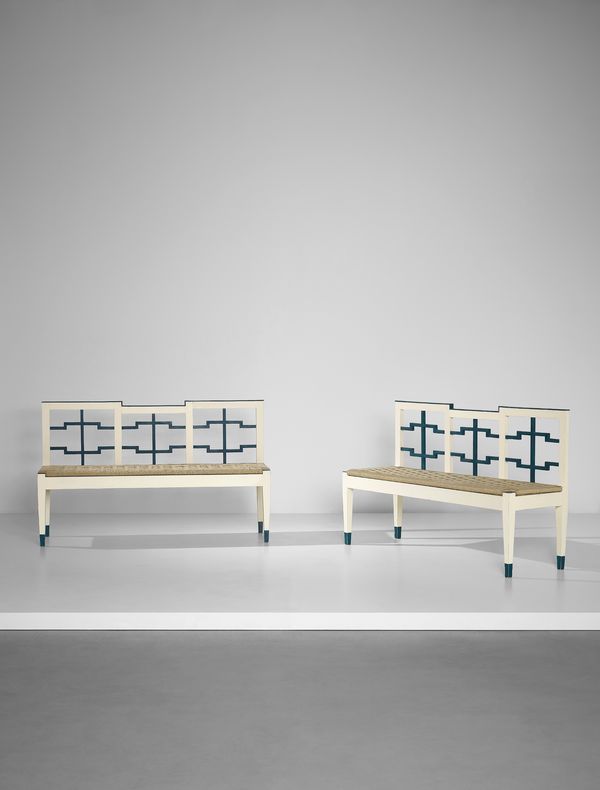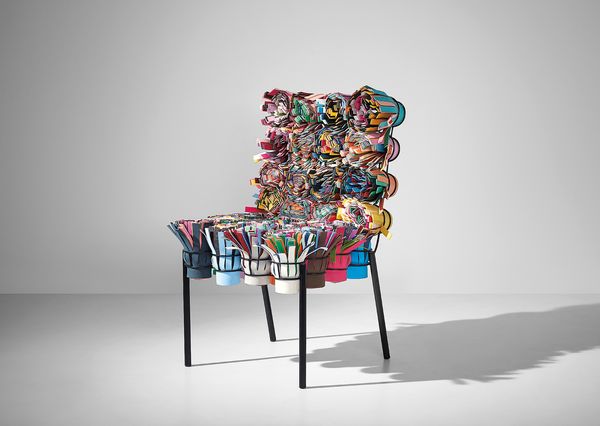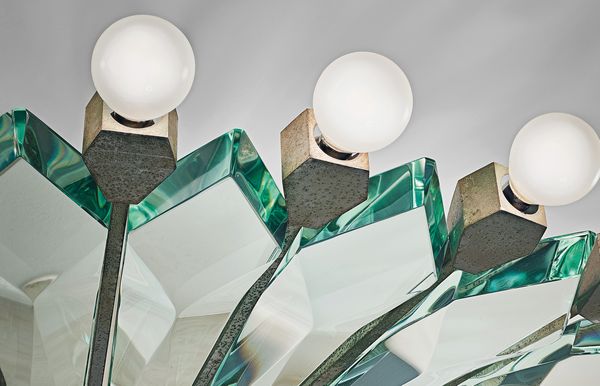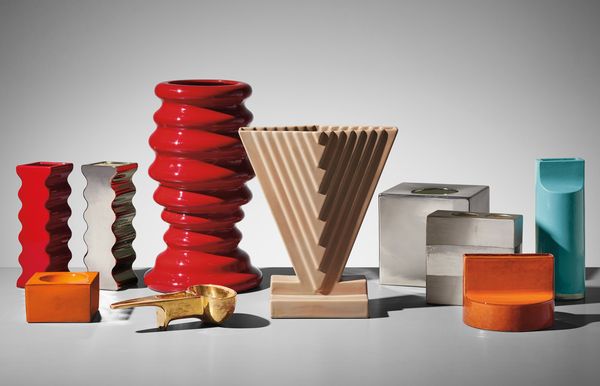Specialist Sofia Sayn-Wittgenstein in front of Line Vautrin mirrors at Phillips Berkeley Square
Artsy: Can you begin by describing the section of ceramics and textiles that leads the sale? What do you find so compelling about this grouping, both for new and seasoned design collectors?
Sofia Sayn-Wittgenstein: It has become more and more difficult to source works of this calibre. Not only are these pieces in immaculate condition compared to what one typically finds on the market, but also their provenance is hugely important. The Peter Collingwood textiles, for example, come from his personal collection. These are works that he held back from the market while exploring and developing his radical modernist ideas around weaving.
Works by Collingwood, Rie and Coper lead the sale
Similarly, some of the Lucie Rie pieces are from her own collection and were retained as the best examples of their type of show prospective buyers. The Hans Coper section includes a very personal gift to his brother, from who he was separated during Anschluss, the annexation of Austria into Nazi Germany in the late 1930s, which ended up in Argentina. Overall, it is a curated group that is very well-researched and documented. Over time, these stories will remain very important to both old and new collectors.
A: Your sale also features exceptional examples of seating from the 20th century, from a 1920s André Groult 'Gondole' chair in mahogany to Jean Royère chaise longues upholstered in goat fur. Can you describe your personal favorites?
SSW: I am glad that you picked up on the large variety of works we are offering. In this sale we have a Charles Rennie Mackintosh from 1898 alongside the Crochet chair designed by Marcel Wanders in 2006. We aim to offer a diversity of 20th and 21st century design to appeal to a broad range of collectors and enthusiasts.
Specialist Sofia Sayn-Wittgenstein poses next to Charles Rennie Mackintosh's Armchair with low back, designed for the Billiards and Smoking Rooms, Argyle Street Tea Rooms, 1898-1899
There are so many pieces in this auction I enjoy, and the more time I spend with this sale, the more pieces I would like to take home with me. One of my personal favorites are Gio Ponti's early benches from circa 1930; they carry a neoclassical elegance interwoven with a modernist touch that you find so often in his work — in this case, with his use of white and blue. They also reference Wiener Werkstätte, a movement that was influenced by neoclassical architecture and focused on bringing purer geometric forms into design. Ponti very much admired and was inspired by the Wiener Werkstätte, which I understand all too well as it is one of my favorite movements in Design.
Gio Ponti Pair of early benches, circa 1930
A: How do these early modern and mid-century modern chairs compare to the later postmodern and contemporary chairs (Ron Arad, Marcel Wanders, Campana Brothers) in the sale?
SSW: Ultimately, whether modern or contemporary, the work is a designer's interpretations of the function a chair should have at the time it was conceived. Take the Jean Prouvé semi-metal chair, for example, created shortly after the Second World War. A humanist in his approach to design, Prouvé had an avant-garde attitude in regards to production and execution. He was occupied with using materials, such as sheet metal, and technologies that would allow him to create affordable mass-produced furniture, predominantly used for public spaces. Any sort of ornamentation in his design was totally out of the question.
Compare that with the Sushi chair, designed by the Campana Brothers in 2005, in Brazil, at a time when the economy was booming. Their designs are meant to be fun and vibrant. The Campanas' example conveys an abundance in its use of materials and colors that very much reflects the age of consumption we live in.
Fernando Campana and Humberto Campana 'Sushi III' chair, 2005
A: We notice several standout chandeliers and ceiling lights in this auction. Can you detail the most interesting pieces of lighting on offer?
SSW: The standout chandelier in its monumentality is surely the chandelier by Napoleone Martinuzzi, at three meters in height. It was executed by the famous Cenedese workshops in Murano in 1960s, and was actually one of the last works he ever made. The chandelier, produced in its entirety with hand-blown glass, incorporates Martinuzzi's signature element from the iconic cactus series the artist designed for Venini more than thirty years earlier. The work was first installed in the Cenedese showrooms until a private Venetian collector acquired it from there.
My personal favorite, however, must be the rare ceiling light by Max Ingrand, which he designed for Fontana Arte in 1958. When he joined Fontana Arte in 1954 as the artistic director, he got access to their archive, as well as the most incredible craftsmen working for the company, of course. The chandelier is a perfect testimony to this flourishing relationship between the designer and the manufacturer, especially when you look at the way the thick crystal is cut.
Max Ingrand Rare ceiling light, model no. 2243, circa 1958 (detail)
A: Ettore Sottsass has received significant attention of late with his Met Breuer exhibition in New York, 'Design Radical', presenting over five decades of his iconoclastic work. Tell us about this opportunity to own vases and ceramics by him.
SSW: The market has been quite focused on Sottsass for a while, perhaps more so by the most dedicated collectors. But yes, the Met Breuer exhibition has brought lots of attention to Sottsass to a larger audience. Other exhibitions that have broadened the interest in his work include the exhibition at the Olivetti showrooms during the Venice Biennale this year, as well as the Sottsass glass exhibition at the Stanze del Vetro in Venice.
A group of ceramic designs by Ettore Sottsass are featured in this month's sale
Marking the centenary of his birth, the Triennale Museum opened a monographic show on Sottsass last Thursday as well. More and more people are starting to recognize the uniqueness in his design.
The ceramics we are offering are a wonderful selection of some of his most iconic designs, and all of the works have attractive estimates.







